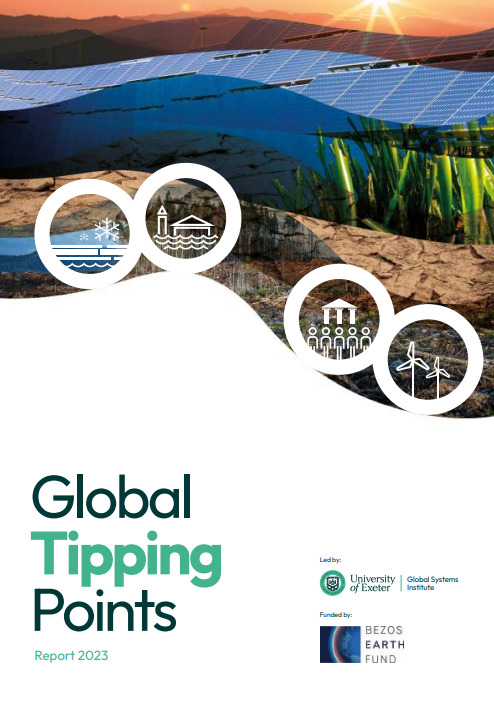The Global Tipping Points Report 2023 explores potential tipping points, which are sudden, potentially irreversible changes in the Earth’s system or society triggered by minor fluctuations in factors like temperature or resource depletion. According to the report, the Earth is dangerously close to five critical climate tipping points, with another three also at significant risk.
Alarmingly, these tipping points could become highly dangerous with temperature rises between 1.5°C and 2.5°C and extremely dangerous between 2.5°C and 4°C. On a brighter note, the report also discusses “positive tipping points”, such as the decreasing cost of renewable energy and increasing sales of electric vehicles. However, these positive changes need certain conditions to thrive, including market stimulation, business regulation, public education and mobilization.
Five Catastrophic Climate Tipping Points
- Collapse of the Greenland Ice Sheet: This could cause a significant rise in sea levels, affecting coastal areas and communities.
- Collapse of the West Antarctic Ice Sheet: A collapse could also lead to a substantial rise in sea level, threatening coastal regions.
- Collapse of Two Parts of the East Antarctic Ice Sheet: The collapse of these ice sheets could further increase sea levels, with extensive consequences.
- Widespread Permafrost Thawing: Permafrost thawing could release significant greenhouse gases, exacerbating global warming.
- Death of Coral Reefs in Warm Waters: The loss of coral reefs could severely impact marine ecosystems and the communities that rely on them.
Potential consequences
- Loss of entire ecosystems: The collapse of significant ice sheets, extensive permafrost thawing, and coral reef die-off in warm waters could result in the loss of entire ecosystems, impacting biodiversity and the services they provide.
- Disruptions to staple crop growth: The breakdown of essential currents in the North Atlantic, like the Atlantic Meridional Overturning Circulation (AMOC), could disrupt rainfall patterns, affecting food sources for billions of people.
- Mass displacement: Changes in climate patterns and ecosystem loss could lead to the mass displacement of people, resulting in social and economic challenges.
- Political instability: The fallout from surpassing climate tipping points could heighten political instability as countries and regions grapple with adapting to the changing climate.
- Financial collapse: The economic implications of climate change, such as disruptions to food production and loss of ecosystems, could instigate financial collapse in some regions.
- Increase in violence and conflict: Surpassing key climate tipping points could have catastrophic impacts on human societies, including a rise in violence and conflict.
Section 1 Earth system tipping points
Provides an overview of Earth system tipping points (ESTPs) and their potential impacts on the planet. Initially, it defines ESTPs as critical thresholds in the Earth system that, when crossed, could trigger abrupt and irreversible changes with significant and far-reaching consequences.
Subsequently, the section highlights the complex and interconnected nature of Earth systems and the potential for tipping points to trigger cascading effects that could amplify and accelerate the impacts of global environmental change. Furthermore, it emphasizes the potential for tipping points to interact with each other, creating feedback loops and reinforcing positive or negative outcomes.
Continues to explore various examples of ESTPs across different Earth systems, including the cryosphere, oceans, land, and atmosphere. Specifically, it discusses the potential for tipping points in ice sheets and glaciers to contribute to sea-level rise. Similarly, it expounds on the potential for tipping points in marine ecosystems to trigger cascading effects on biodiversity and fisheries and the potential for tipping points in forests and grasslands to contribute to carbon emissions and biodiversity loss.
Moreover, it also highlights the potential for tipping points in the climate system to trigger abrupt changes in temperature, precipitation patterns, and extreme weather events. It also discusses the potential for tipping points in air quality to impact human health and ecosystems.
Overall, underscores the need for continued efforts to understand and monitor ESTPs and to develop and implement effective prevention, adaptation, and resilience strategies. It emphasizes the importance of interdisciplinary and collaborative approaches to addressing the complex and interconnected nature of ESTPs and their impacts. As a final point, it highlights the urgency of action to prevent and mitigate the impacts of ESTPs, recognizing the high stakes and the burden of responsibility on present and future generations.
Section 2 Tipping point impacts
Offers a comprehensive exploration of the potential impacts of tipping points across various Earth systems, notably the cryosphere, oceans, land, and atmosphere. Importantly, this section emphasizes these systems’ complex and interconnected nature and the potential for tipping points to set off cascading effects that could have significant and wide-ranging consequences.
Specifically regarding the cryosphere, it discusses the potential for tipping points in ice sheets and glaciers to contribute to sea-level rise. This could notably impact coastal communities and infrastructure. In addition, it explores the potential for tipping points in permafrost to release large amounts of greenhouse gases, a factor that could further exacerbate climate change.
Moving onto the oceans, it highlights the potential for tipping points in marine ecosystems, such as coral reefs and kelp forests. These tipping points could create cascading effects on biodiversity, fisheries, and coastal protection. It also discusses the potential for tipping points in ocean circulation patterns to influence global climate and weather patterns.
Regarding the land system, it delves into the potential for tipping points in forests, grasslands, and peatlands. These tipping points could contribute to carbon emissions, biodiversity loss, and changes in hydrological cycles. It also discusses the potential for tipping points in agricultural systems to impact food security and land use patterns.
Transitioning to the atmosphere, the section underscores the potential for tipping points in the climate system to trigger abrupt changes in temperature, precipitation patterns, and extreme weather events. Furthermore, it also discusses the potential for tipping points in air quality to impact human health and ecosystems. Above all else, it strongly emphasizes the importance of interdisciplinary and collaborative approaches to addressing the complex and interconnected nature of tipping points and their impacts.
Section 3 Governance of Earth system tipping points
Delivers a comprehensive overview of Earth system tipping points (ESTPs) governance. Initially, it highlights the urgent need for a governance framework that prioritizes efforts to prevent tipping events, minimize impact-related harms, foster adaptation and resilience, and facilitate knowledge co-production. Importantly, it emphasizes the necessity of addressing the multiple interacting drivers of ESTPs, which often operate at different scales. Moreover, it underlines the significance of primary drivers, such as global temperature change, and passionately advocates for accelerated mitigation of greenhouse gases as a crucial prevention strategy.
In addition, it also emphasizes the need for global institutions across multiple domains to consider the implications of tipping processes for effective operation and to adjust existing frameworks for governing the impacts of global environmental change. Interestingly, it suggests a ‘polycentric’ governance architecture that distributes responsibilities for prevention and impact governance across multiple sites and scales of action. This approach acknowledges that ESTPs are complex and multifaceted, requiring a collaborative and coordinated effort across different sectors and levels of governance.
Furthermore, the section also highlights the high stakes and the burden of responsibility on present generations, advocating for precautionary approaches and systemic risk governance to guide decision-making. Notably, it emphasizes the importance of anticipatory approaches and systemic risk governance in addressing scientific uncertainty and guiding decision-making. Ultimately, it concludes by emphasizing the need for continued efforts to develop and implement effective governance frameworks for ESTPs, recognizing the critical role of governance in shaping the planet’s future.
Section 4 Positive tipping points in technology, economy and society
Delves into potential positive tipping points in technology, economy, and society. These tipping points could lead to transformative changes that positively impact sustainability, social justice, and human well-being. Importantly, it emphasizes the central role of innovation, policy, and collective action in facilitating and accelerating these positive tipping points.
In the realm of technology, it explores notable examples such as the rapid growth of renewable energy, advancements in energy storage technologies, and the increasing adoption of sustainable transportation solutions. Moreover, it discusses the potential for breakthrough innovations such as carbon capture and utilization, sustainable materials, and clean technologies, which could contribute to positive tipping points in addressing environmental challenges.
Turning to the economy, it highlights the rise of circular economy models, sustainable finance initiatives, and the growing integration of environmental, social, and governance (ESG) considerations into business practices. In addition, it discusses the potential for positive tipping points in economic systems through the promotion of sustainable consumption and production patterns and the development of green markets and sustainable supply chains.
In the societal context, it explores the potential for positive tipping points in social and political spheres, such as increasing awareness and mobilization around climate change, social justice issues, and sustainable development goals. Furthermore, it discusses the influential role of education, advocacy, and social movements in driving positive societal tipping points towards more sustainable and equitable futures. Lastly, the section emphasizes the importance of policy support, investment, and collaboration to accelerate the transition towards more sustainable and equitable systems.
Recommendations
Underscores the urgent need to address these tipping points and take bold climate action to avert irreversible and severe consequences. This warning is particularly timely as world leaders gather for the COP28 climate summit in Dubai, highlighting the necessity to limit global temperature rises to mitigate these tipping point risks.
- Immediate Reduction of Greenhouse Gas Emissions: The report stresses the urgent need for decisive climate action, including lowering greenhouse gas emissions and limiting global temperature rise, to mitigate the risks of these tipping points.
- Change in Climate Policy: The report endorses a shift in how tipping points are currently addressed in climate policy and offers suggestions for incorporating climate risk into policy decisions.
- Adaptation and Technological Innovation: The report promotes adaptation and technological innovation to lessen the risks tied to climate tipping points.
- Global Summit on Tipping Points: The report suggests convening a global summit for policymakers, scientists, and other stakeholders to discuss the risks and opportunities associated with tipping points.
- Enhanced Understanding of Tipping Points: The report advises developing a deeper understanding of tipping points and converting this knowledge into action, including coordinated efforts to instigate positive ones.
- Transformative Approaches to Climate Policy: The report proposes transformative approaches to climate policy, like integrating tipping point analysis into climate policy mechanisms such as globally and nationally determined contributions.




